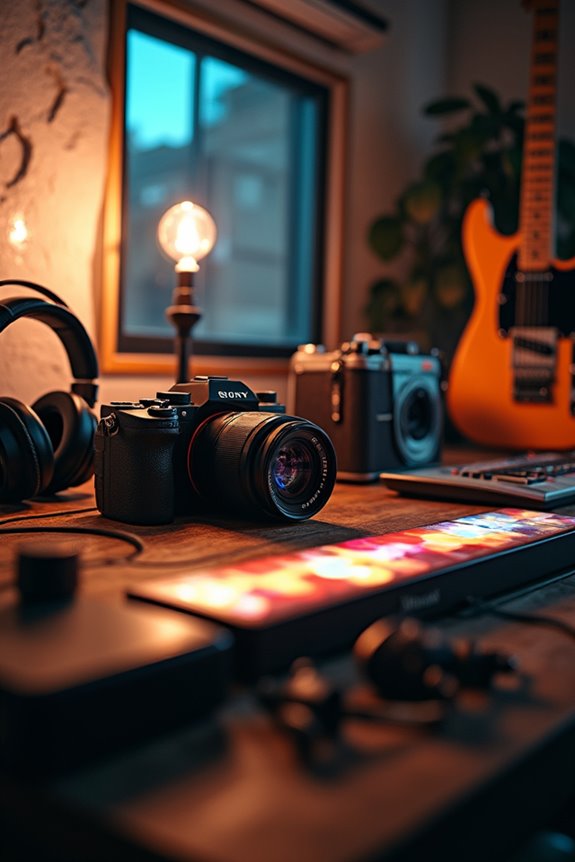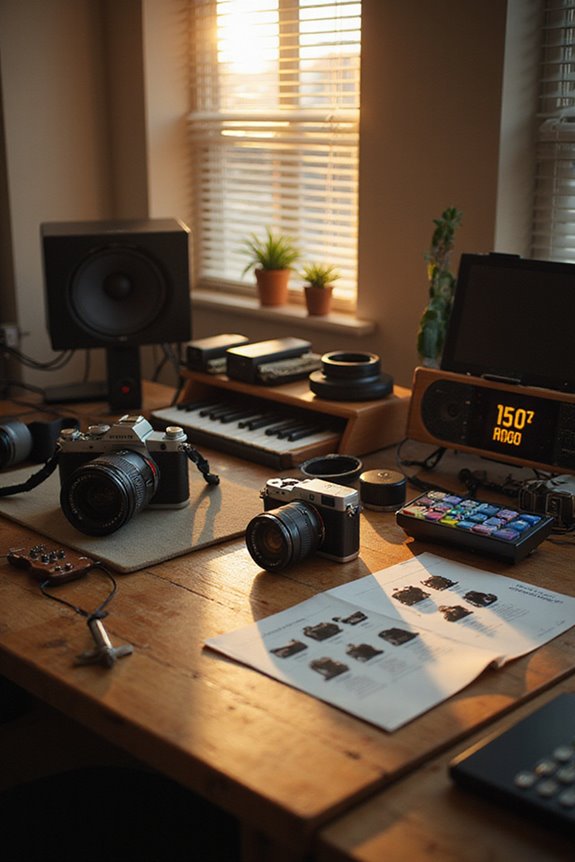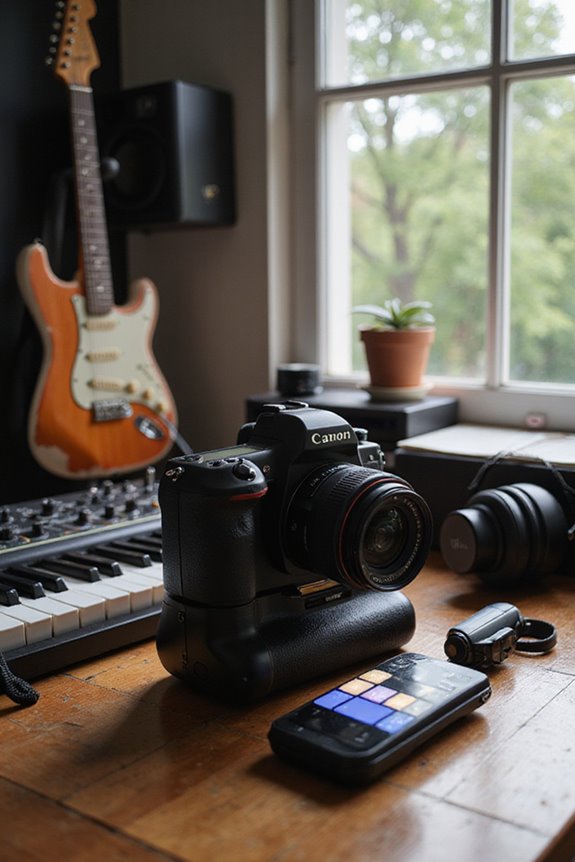When we start with a new camera, certain accessories are crucial to get the most out of our gear. First, a sturdy camera bag with protective padding keeps equipment safe during travel. We should also have high-capacity memory cards, like SDXC, for storing high-resolution photos. Spare batteries guarantee we’re never caught short during shoots. Incorporating a lightweight tripod stabilizes our shots, and having lens cleaning equipment is essential. There’s much more to explore, so let’s keep going!
Key Takeaways
- Invest in durable camera bags for protective storage, ensuring your gear stays safe during photography outings.
- Acquire high-speed memory cards like SDXC or CFexpress for optimal performance, particularly for high-resolution photos and 4K video.
- Carry spare batteries to avoid interruptions during shoots, opting for lightweight lithium-ion batteries for convenience and longevity.
- Use a sturdy tripod or stabilization gear for improved stability, enhancing your shooting experience and achieving sharp images.
- Keep lenses clean with air blowers and microfiber cloths; consider lens cleaning pens for difficult stains to maintain optimal performance.
Camera Bags and Storage Solutions
When we consider capturing stunning images, having the right camera bag is essential, as it protects our valuable gear while enhancing our shooting experience. There are various camera bag styles, like backpacks and messenger bags, each offering unique advantages. Backpacks are great for versatile storage, accommodating multiple camera bodies and lenses, while messenger bags provide quick access during urban photography.
When selecting a bag, we should prioritize protective features such as the M-Guard™ Protection System and quality padding, which safeguard our equipment from bumps and scratches. Additionally, rain covers are vital for outdoor shoots. By choosing the right style and focusing on these protective features, we can keep our gear safe and organized, no matter where our photography adventures take us. Furthermore, durability and material are critical factors that ensure the longevity of our bags against various weather conditions and wear.
Memory Cards and External Storage

After we’ve confirmed our camera gear is securely stored in a quality bag, the next vital aspect is selecting the right memory cards and external storage options. Understanding memory card types is essential; for most, SD cards—especially SDXC—provide excellent storage capacity, reaching up to 2TB for high-resolution images and videos. For high-speed needs, CFexpress cards are the gold standard, offering performance that’s essential for burst shooting. Additionally, using portable SSDs for offloading files guarantees our workflow remains efficient without bottlenecks. This combo of choosing compatible memory cards and reliable external storage not only protects our valuable media but also enhances our shooting experience, allowing for uninterrupted creativity during those important moments. High-speed memory cards, especially those with UHS speed classes, are crucial for tasks like 4K video recording, ensuring smooth performance.
Spare Batteries and Power Solutions
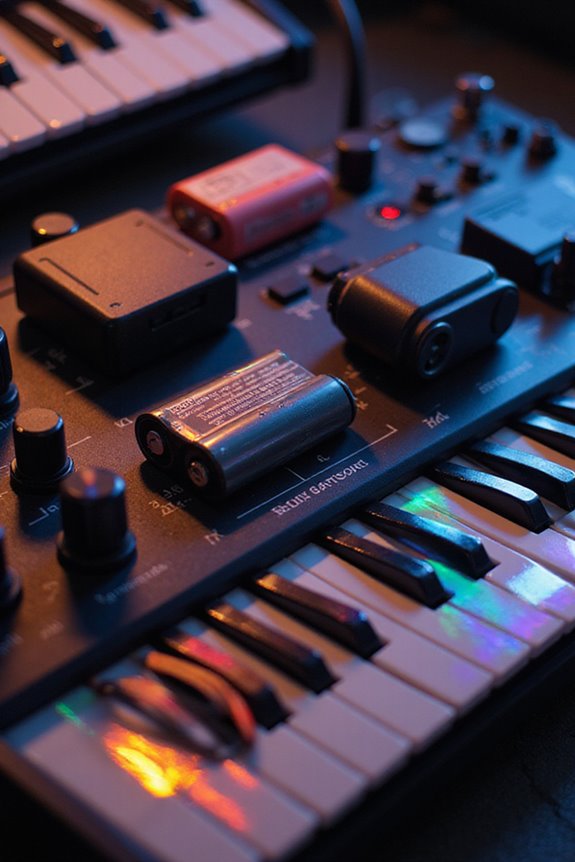
In our quest for seamless shooting experiences, spare batteries and power solutions play a crucial role that we can’t overlook. Understanding different battery types, like lithium-ion and nickel-metal hydride, helps us choose wisely. Lithium-ion batteries are lightweight and have a longer lifespan, while NiMH options can weigh us down during long shoots.
To optimize power management, we should always carry at least one fully charged spare battery. For extended shoots, external V-mount batteries offer reliable support, allowing us to power our cameras and accessories simultaneously. Keeping a set of disposable batteries for emergencies is a smart move, too. Ultimately, proper battery care and management can enhance our photography, ensuring we capture all those special moments without interruption.
Tripods and Stabilization Gear
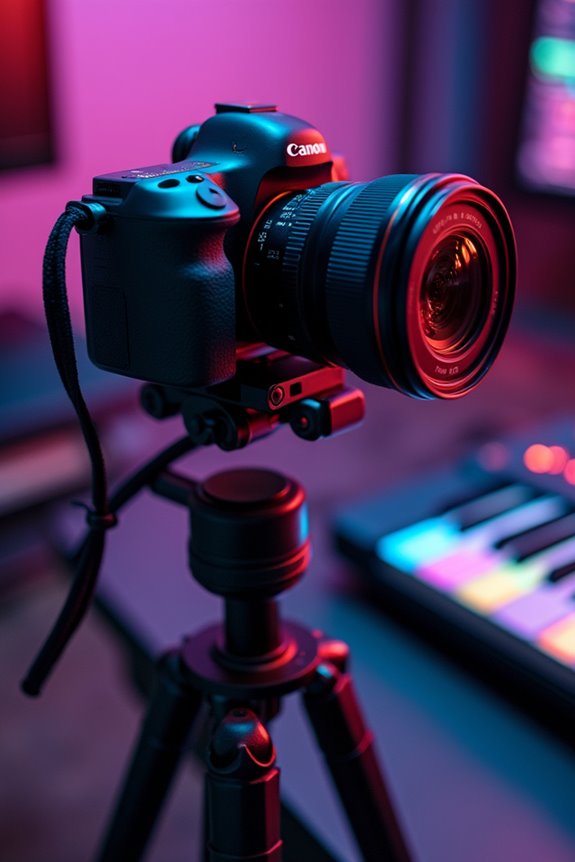
Capturing stunning images often relies on the stability provided by tripods and stabilization gear, which enhance our shooting experience just as spare batteries do for powering our devices.
When selecting tripods, we have various types to take into account, including lightweight travel tripods for easy portability and sturdy studio tripods with high load capacity for heavier setups. Material choices also come into play; aluminum offers great stability, while carbon fiber provides a lightweight option for those on the go.
It’s essential to evaluate head functionality, with ball heads for quick adjustments and gimbal heads for smooth movement during action shots. With ergonomic designs and versatility through adjustable leg angles, we can adapt to uneven terrain, ensuring we’ve got the right support for every shot. Understanding load capacity is critical to ensure that your tripod can safely support your camera and accessories.
Lenses and Cleaning Equipment
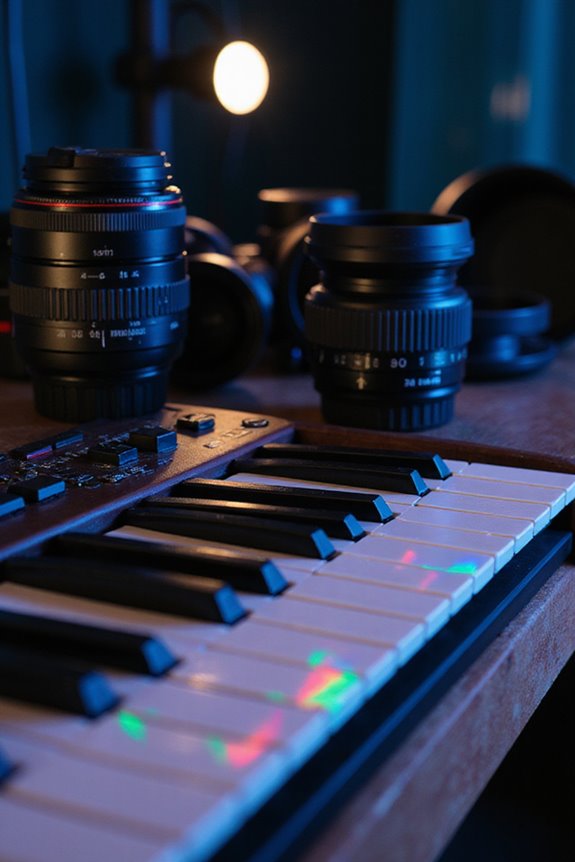
Lenses can make or break our photography experience, offering a range of creative possibilities tailored to different shooting scenarios. We can choose from various lens types, like prime lenses for stunning portraits and low-light shots, or versatile zoom lenses that adapt to diverse environments. Macro lenses excel at capturing fine details, while wide-angle and telephoto options enhance our landscape and wildlife photography.
To keep our lenses in prime condition, we should adopt effective cleaning techniques. Always start with air blowers to remove loose dust, then use a microfiber cleaning cloth with a few drops of cleaning solution. Regular cleaning not only preserves the lens but also guarantees crisp, clear images, allowing our creativity to shine. Investing in a quality lens cleaning pen with carbon cleaning tips ensures safe and effective removal of stubborn stains like fingerprints and oils.
Lighting Accessories
Understanding how to harness proper lighting can markedly improve our photography results. For new camera users, investing in both continuous lighting and flash lighting is essential. Continuous lighting, like LED panels, provides a steady, adjustable light source perfect for video and stills. Ring lights are fantastic for portraits, offering soft illumination that reduces shadows. On the other hand, speedlights and studio strobes deliver powerful light bursts ideal for freezing motion. For accent lighting, strip lights and other focused options can highlight specific details. Many of these accessories come with dimming capabilities, giving us total control over brightness. By selecting the right lighting accessories, we can markedly enhance our images and achieve professional-quality results. Additionally, exploring options like softboxes for diffusing light can further improve the quality and softness of our lighting.
Filters and Effects
For a dash of creativity, effects filters can elevate our images. Starburst filters create light spikes around points of light, while Pro-Mist filters soften images, giving them a dreamy quality. We can also explore colored filters to dramatically change the mood or refine our color balance. By utilizing these filters, we’re set to expand our artistic vision and improve our photography capabilities.
Remote Shutter Releases
When capturing those perfect shots, we often encounter situations where steady hands simply aren’t enough. That’s where remote shutter releases come into play. With wired remotes, we enjoy a reliable connection, while infrared (IR) remotes allow for simple trigger action within limited range limitations. Bluetooth remotes offer wireless convenience but can pose compatibility issues with certain camera models. Meanwhile, RF remotes boast impressive ranges of over 190 feet, operating without needing a line of sight. Many of these remotes feature intuitive timer functions, improving shooting efficiency for time-lapses or self-portraits. By choosing the right type, we can enhance our photography experience and capture stunning images without camera shake, even in challenging conditions.
Digital Editing Software
Digital editing software has become an essential tool for photographers, whether we’re beginners or seasoned pros. When we plunge into photo editing, choosing the right software matters. Popular options include Adobe Photoshop, which boasts powerful tools for professionals, and Adobe Lightroom, perfect for those who need intuitive organization. For a premium touch, Capture One Pro excels in studio settings. If we prefer a one-time purchase, Affinity Photo 2 and Luminar NEO offer robust capabilities without recurring fees. In our software comparison, we might also explore free alternatives like GIMP or Snapseed for quick edits. Each option presents unique features like AI tools, RAW processing, and seamless syncing—all tailored to streamline our editing process and enhance our images.
Frequently Asked Questions
What Should I Consider When Choosing a Camera Brand?
When choosing a camera brand, we should consider important camera features and brand reputation. Each brand excels in different aspects, so evaluating our needs will guide us to the best fit for our photography journey.
How Do I Select the Right Camera for Beginners?
When it comes to selecting the right camera for beginners, we’ve gotta consider camera types and features. With some solid beginner tips, we can help guarantee a smooth start in our photography journey!
Are Camera Insurance or Warranties Necessary?
When it comes to camera coverage, we believe warranties offer essential protection against defects, but they often fall short. That’s why we find insurance beneficial, covering accidental damage and loss that warranties typically don’t.
What Is the Best Way to Store Digital Photos Long-Term?
When it comes to keeping our cherished memories safe, we’d say cloud storage and external drives are our best friends. They offer security and accessibility, ensuring our photos are preserved for many years to come.
How Often Should I Update My Photography Gear?
When considering how often we should update our photography gear, it’s important to prioritize gear longevity and meaningful upgrades. Let’s evaluate upgrade frequency based on our specific needs and goals, rather than following trends blindly.

